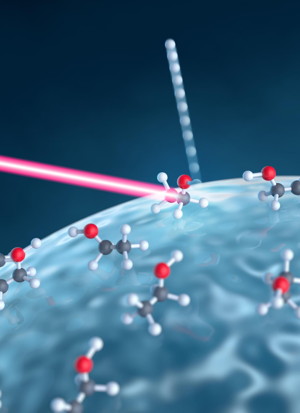Home > Press > Physics: An ultrafast glimpse of the photochemistry of the atmosphere
 |
| This is an ultrafast glimpse of the photochemistry of the atmosphere CREDIT Matthias Kling |
Abstract:
Researchers at Ludwig-Maximilians-Universitaet (LMU) in Munich have explored the initial consequences of the interaction of light with molecules on the surface of nanoscopic aerosols.
Physics: An ultrafast glimpse of the photochemistry of the atmosphere
Munich, Germany | Posted on October 11th, 2019The nanocosmos is constantly in motion. All natural processes are ultimately determined by the interplay between radiation and matter. Light strikes particles and induces reactions. By altering the energy states of electrons, it reshuffles atoms and causes molecules to be reconfigured. These processes are significantly accelerated when the reactants are absorbed on the surface of nanoparticles in the atmosphere. This phenomenon is crucial for the photochemistry of the atmosphere and thus has an impact on our health and climate. One of the light-driven molecular processes that takes place on aerosols has now been investigated in detail by researchers led by Professir Matthias Kling and Dr. Boris Bergues at the Laboratory for Attosecond Physics, which is operated jointly by the LMU Munich and the MPQ. The group has developed a new method, called reaction nanoscopy, which makes it possible to study elemental physicochemical transitions on solid interfaces. They have now used it to characterize the reaction of ethanol with water molecules on the surface of glass nanoparticles under the influence of high-intensity laser light. The researchers irradiated the spherical particles with ultrashort laser pulses, each lasting for a few femtoseconds. A femtosecond is a millionth of a billionth of a second. With the aid of reaction nanoscopy, they were able to record this ultrashort interaction in three dimensions with nanometer resolution. "We have observed the detachment and acceleration of hydrogen ions from molecules on the surface of nanoparticles. The ability to do so forms the basis for the high spatial resolution of our imaging technique," explains Boris Bergues. "Because the technology enables us to determine the exact position on the nanoparticle with the highest reaction yield, we can trace reactions of molecules adsorbed on the surface of aerosols with high spatial resolution", adds Matthias Kling. Such processes are ubiquitous, especially in the fields of atmospheric physics and astrochemistry. For example, light in our atmosphere interacts with aerosols and their attached molecules, triggering subsequent reactions that may be important for the development of our climate. In the short term, the results obtained with the new analytical procedure by the Munich laser physicists may provide useful insights, especially in the field of atmospheric chemistry.
####
For more information, please click here
Contacts:
Kathrin Bilgeri
49-892-180-3423
Copyright © Ludwig-Maximilians-Universität München (LMU)
If you have a comment, please Contact us.Issuers of news releases, not 7th Wave, Inc. or Nanotechnology Now, are solely responsible for the accuracy of the content.
| Related Links |
| Related News Press |
News and information
![]() Simulating magnetization in a Heisenberg quantum spin chain April 5th, 2024
Simulating magnetization in a Heisenberg quantum spin chain April 5th, 2024
![]() NRL charters Navy’s quantum inertial navigation path to reduce drift April 5th, 2024
NRL charters Navy’s quantum inertial navigation path to reduce drift April 5th, 2024
![]() Discovery points path to flash-like memory for storing qubits: Rice find could hasten development of nonvolatile quantum memory April 5th, 2024
Discovery points path to flash-like memory for storing qubits: Rice find could hasten development of nonvolatile quantum memory April 5th, 2024
Chemistry
![]() What heat can tell us about battery chemistry: using the Peltier effect to study lithium-ion cells March 8th, 2024
What heat can tell us about battery chemistry: using the Peltier effect to study lithium-ion cells March 8th, 2024
![]() Nanoscale CL thermometry with lanthanide-doped heavy-metal oxide in TEM March 8th, 2024
Nanoscale CL thermometry with lanthanide-doped heavy-metal oxide in TEM March 8th, 2024
Discoveries
![]() Chemical reactions can scramble quantum information as well as black holes April 5th, 2024
Chemical reactions can scramble quantum information as well as black holes April 5th, 2024
![]() New micromaterial releases nanoparticles that selectively destroy cancer cells April 5th, 2024
New micromaterial releases nanoparticles that selectively destroy cancer cells April 5th, 2024
![]() Utilizing palladium for addressing contact issues of buried oxide thin film transistors April 5th, 2024
Utilizing palladium for addressing contact issues of buried oxide thin film transistors April 5th, 2024
Announcements
![]() NRL charters Navy’s quantum inertial navigation path to reduce drift April 5th, 2024
NRL charters Navy’s quantum inertial navigation path to reduce drift April 5th, 2024
![]() Discovery points path to flash-like memory for storing qubits: Rice find could hasten development of nonvolatile quantum memory April 5th, 2024
Discovery points path to flash-like memory for storing qubits: Rice find could hasten development of nonvolatile quantum memory April 5th, 2024
Interviews/Book Reviews/Essays/Reports/Podcasts/Journals/White papers/Posters
![]() Simulating magnetization in a Heisenberg quantum spin chain April 5th, 2024
Simulating magnetization in a Heisenberg quantum spin chain April 5th, 2024
![]() Discovery points path to flash-like memory for storing qubits: Rice find could hasten development of nonvolatile quantum memory April 5th, 2024
Discovery points path to flash-like memory for storing qubits: Rice find could hasten development of nonvolatile quantum memory April 5th, 2024
Environment
![]() Billions of nanoplastics released when microwaving baby food containers: Exposure to plastic particles kills up to 75% of cultured kidney cells July 21st, 2023
Billions of nanoplastics released when microwaving baby food containers: Exposure to plastic particles kills up to 75% of cultured kidney cells July 21st, 2023
|
|
||
|
|
||
| The latest news from around the world, FREE | ||
|
|
||
|
|
||
| Premium Products | ||
|
|
||
|
Only the news you want to read!
Learn More |
||
|
|
||
|
Full-service, expert consulting
Learn More |
||
|
|
||








